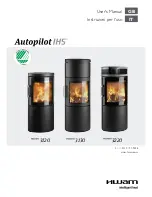
Vermont Castings • Dauntless FlexBurn Owner’s Manual_R3 • 2020 - ___ • 05/20
19
3-90-586000c
When to Suspect a Combustor Problem
The best way to evaluate the performance of your Dauntless
FlexBurn’s combustor is to observe the amount of smoke
leaving the chimney — both when the combustor has “lighted-
off” and when it has not. Follow these steps:
• With a fire going and the combustor properly activated and
the damper closed to route smoke through it as described
in the Operation Section, go outside and observe the
smoke leaving the chimney.
• Then, open the stove damper and once again check the
smoke leaving the chimney.
You should see significantly more smoke when the stove
damper is open and exhaust does not pass through the
combustor. However, be careful not to confuse smoke with
steam from wet wood. Steam dissipates in the air quickly;
smoke does not. Remember that a hot stove with a 2”-3”
established coal bed is required for catalytic combustion to
occur.
If this test indicates a problem, consider other possible factors
as well, such as the weather or a change in the quality of
your fuel. In warm weather, draft is weaker than it is in colder
winter weather, and fires can burn sluggishly. Small, hot fires
are a good solution under these conditions.
Figure 3.8
- Inspect the catalytic combustor.
Catalyst
Access Door
Also, consider any changes in your operating routine.
Once you have ruled out any other possible causes for a
decline in performance, inspect and clean the combustor if
necessary. Be sure to protect any surface you use for setting
the stove parts aside.
Inspecting the Combustor
Remove access door and inner firebrick. Remove the catalytic
combustor by lifting up and pulling towards you, Figure 3.8.
NOTE
Burning “green” (insufficiently seasoned) wood will result
in poorer performance than burning properly seasoned
fuel. Reloading with green wood can also thermal shock
the catalyst, resulting in cracking, or the eventual fallout,
of the honeycomb substrate. You may have to run your
stove hotter (more air) to achieve acceptable performance
using green or wet wood.
Cleaning the Optional Combustor
1. Check the combustors honeycomb-like catalyst for a
buildup of fly ash. If any is evident, take the catalyst
outside and clean it by blowing air gently through it. Do
not push anything through the honeycomb; the combustor
should be cleaned by forcing air through the combustor
to remove fly ash using a vacuum or can of compressed
air.
2. Inspect the catalyst for damage or degradation. Although
small hairline cracks will not affect performance, the
catalyst should be essentially intact. If the catalyst is
broken in pieces or has sections missing, it should be
removed or replaced. Call your local Vermont Castings
Authorized Dealer for a replacement catalyst.
3. If the catalyst is in good condition and clean, re-install it
in the stove and replace the refractory access door.










































